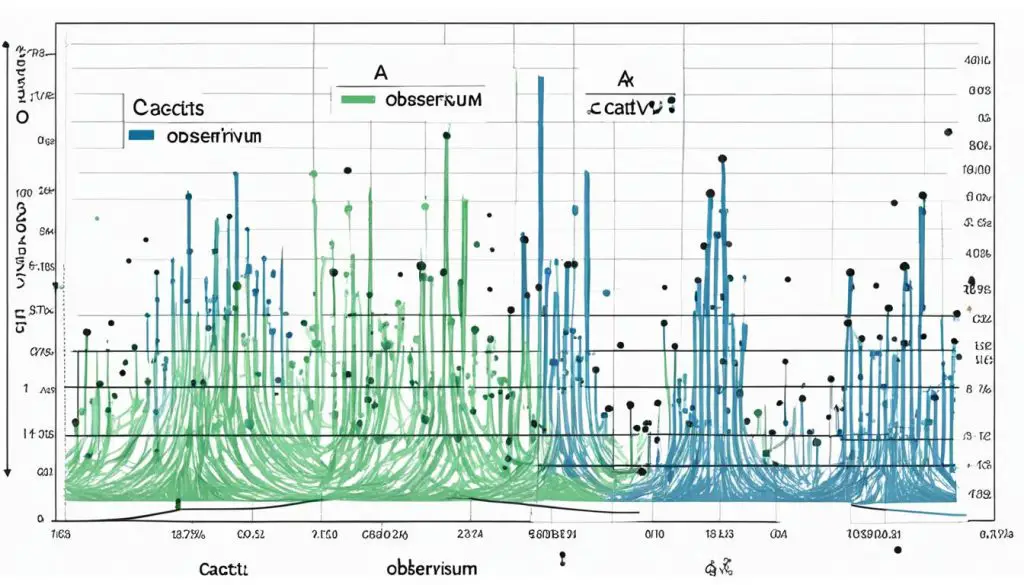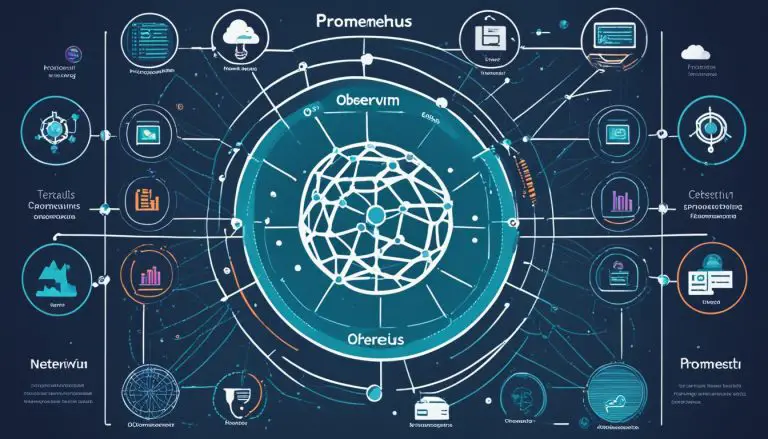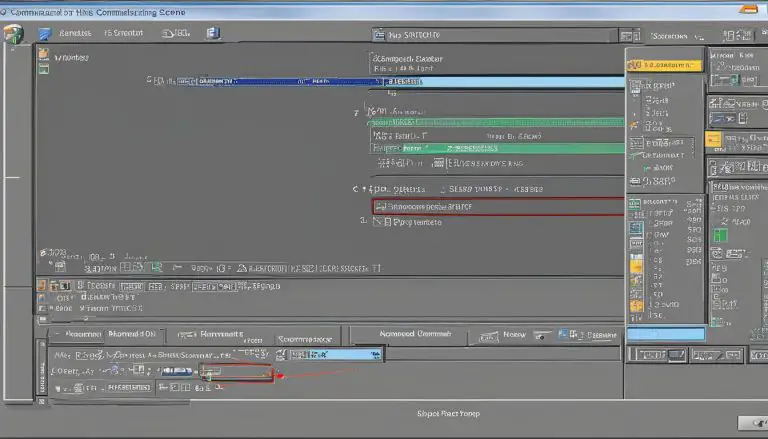Cacti vs. Observium: Network Monitoring Compared
When it comes to network monitoring tools, Cacti and Observium are two popular options. But which one is better? Are there significant differences in features and performance? And what do user reviews say about these tools? In this article, I will compare Cacti and Observium, exploring their features, capabilities, pros, and cons. By the end, you’ll have a clearer understanding of which network monitoring tool may be the best fit for your needs.
Key Takeaways:
- Cacti and Observium are both network monitoring tools with unique strengths and weaknesses.
- Cacti excels in graphing and customization, while Observium offers a user-friendly interface and comprehensive network monitoring capabilities.
- Factors such as scalability, resource usage, and ease of integration should be considered when choosing between Cacti and Observium.
- User reviews provide valuable insights into the experiences and satisfaction levels of users of both tools.
- Ultimately, the choice between Cacti and Observium depends on your specific requirements and preferences.
Key Features of Observium
Observium offers a comprehensive set of key features that make it a powerful network monitoring tool. Let’s take a closer look at some of its key capabilities:
Resource Management
Observium provides robust resource management capabilities, allowing you to monitor and manage system resources effectively. This feature enables you to keep track of CPU usage, memory utilization, disk space, and other important resource metrics.
Server Monitoring
With Observium, you can easily monitor the health and performance of your servers. It provides real-time insights into server metrics such as CPU load, network traffic, and disk activity. This helps you identify any issues or bottlenecks and take proactive measures to optimize your server performance.
SLA Monitoring
Ensuring compliance with service-level agreements is crucial for maintaining high-quality service delivery. Observium’s SLA monitoring feature allows you to monitor and track key performance indicators (KPIs) to ensure that you meet your service level commitments.
Uptime Monitoring
Observium helps you ensure the availability and uptime of your network by continuously monitoring network devices and services. It provides real-time alerts and notifications in case of any downtime or service disruptions, allowing you to address issues promptly and minimize downtime.
Bandwidth Monitoring
Bandwidth utilization is a critical factor in network performance. Observium offers robust bandwidth monitoring capabilities that allow you to track the usage, trends, and patterns of your network traffic. This helps you optimize your network resources and identify any bandwidth-intensive applications or devices.
In summary, Observium’s key features make it a versatile network monitoring tool that provides comprehensive resource management, server monitoring, SLA monitoring, uptime monitoring, and bandwidth monitoring capabilities. These features empower network administrators to proactively monitor and manage their networks for optimal performance and reliability.
Key Features of Cacti
Cacti, a powerful network monitoring tool, offers a range of key features that make it a popular choice among network administrators and IT professionals.
Graphing with RRDTool
One of the standout features of Cacti is its graphing functionality, which utilizes the power of RRDTool. This allows users to visually represent network data in a clear and organized manner. With Cacti, you can create insightful graphs that help you monitor network performance, identify trends, and make data-driven decisions.
Customizable Data Sources
To gather specific data for monitoring, Cacti offers customizable data sources. This feature allows you to easily collect and track relevant metrics that are crucial for your network’s performance. Whether it’s traffic usage, server performance, or system health, Cacti provides flexibility in gathering the data that matters most to you.
Templates for Easy Graph Creation
In addition to its powerful graphing capabilities, Cacti simplifies the graph creation process through its template system. Templates in Cacti enable you to create graphs quickly and efficiently, saving you time and effort. With a wide variety of pre-built templates available, you can choose the ones that best suit your monitoring needs and easily modify them to fit your specific requirements.
These key features of Cacti make it a valuable asset for any network monitoring setup. From graphing with RRDTool to customizable data sources and convenient templates, Cacti provides the tools you need to effectively monitor and analyze your network’s performance.
Network Monitoring Capabilities of Observium
In the realm of network monitoring, Observium stands out with its exceptional capabilities. One of its key features is its auto-discovery function, which makes it effortless to identify and monitor network devices. This auto-discovery feature eliminates the need for manual configuration, saving time and reducing errors in the process.
With Observium, network administrators gain enhanced visibility into their network infrastructure. By providing real-time data on network performance and health, Observium enables administrators to proactively identify and address potential issues before they impact the network’s reliability or security.
Long-term network metric collection is another strength of Observium. This powerful capability allows for comprehensive monitoring and analysis of key performance indicators (KPIs) over time. By capturing and storing relevant metrics, Observium empowers network administrators to track trends, identify patterns, and make informed decisions about their network’s performance and optimization.
Moreover, Observium facilitates proactive troubleshooting by alerting administrators to potential threats and anomalies in the network. By automatically monitoring critical parameters such as bandwidth usage, latency, CPU load, and memory consumption, Observium enables administrators to swiftly respond to issues and mitigate their impact.
Benefits of Observium’s Network Monitoring Capabilities:
Auto-Discovery: Observium’s auto-discovery feature simplifies device identification and monitoring.
Enhanced Visibility: Real-time data provides a clear overview of network infrastructure and performance.
Long-Term Metric Collection: Comprehensive monitoring and analysis of network KPIs over time.
Proactive Troubleshooting: Swift detection and alerting of potential threats and anomalies.
Observium’s network monitoring capabilities significantly contribute to proactive network management and the overall health of the network environment. By harnessing auto-discovery, visibility, long-term metric collection, and proactive troubleshooting, network administrators can ensure optimal network performance and minimize downtime.
[](https://seowriting.ai/32_6.png)
Figure 1. Observium Dashboard
Network Monitoring Capabilities of Cacti
When it comes to network monitoring, Cacti offers a range of impressive capabilities that make it a powerful tool for network administrators. At the heart of Cacti’s monitoring capabilities is its graphing functionality, which allows for the visual representation of network data. This visual approach not only makes it easier to understand complex network metrics but also enables administrators to identify trends, patterns, and potential issues at a glance.
In addition to its graphing capabilities, Cacti also supports the use of custom scripts for data gathering. This feature provides administrators with the flexibility to monitor specific metrics that are unique to their network environment. Whether it’s tracking bandwidth usage, monitoring server performance, or gathering data from custom-built applications, Cacti allows for customized monitoring that aligns with the specific needs of the network.
Moreover, Cacti’s ability to gather data from a variety of sources further enhances its monitoring capabilities. It supports various data sources, allowing administrators to collect information from different network devices and systems. With this flexibility, Cacti can seamlessly integrate with existing infrastructure and provide a comprehensive view of the network.
One standout feature of Cacti is its support for SNMP, or Simple Network Management Protocol. SNMP enables administrators to monitor and manage network devices, gather valuable performance data, and proactively troubleshoot potential issues. Cacti’s SNMP support makes it a valuable asset in network monitoring, extending its capabilities beyond simple graphing and data gathering.
To illustrate the power of Cacti’s network monitoring capabilities, take a look at the following image:
This graph showcases the visual representation of network data that Cacti provides, allowing administrators to easily track and analyze network performance over time. With Cacti’s graphing capabilities, data gathering flexibility, and SNMP support, it’s clear that Cacti is a robust network monitoring solution that empowers administrators to effectively monitor and manage their networks.
Pros and Cons of Observium
Observium, as a network monitoring software, offers several strengths that make it a popular choice for many users. Its user-friendly interface ensures ease of use and allows users to navigate the platform effortlessly. The auto-discovery feature is another standout attribute, enabling automatic detection and monitoring of network devices.
Moreover, Observium’s comprehensive network monitoring capabilities provide users with valuable insights into their network resources. With features such as resource management, server monitoring, SLA monitoring, uptime monitoring, and bandwidth monitoring, Observium empowers users to efficiently manage and optimize their networks.
“Observium’s user-friendly interface and auto-discovery feature make it a top choice for network monitoring. Its comprehensive capabilities ensure effective resource management and troubleshooting.”
However, it is important to consider some limitations when using Observium. Customization options might be limited, which could restrict users who require specific configurations or workflows. Additionally, scalability can be a potential concern for larger networks, as Observium’s performance may degrade as network size increases.
Overall, Observium’s strengths in terms of its user-friendly interface, auto-discovery feature, and comprehensive network monitoring capabilities make it a valuable tool for many users. However, users should carefully evaluate their specific requirements and consider the limitations of customization and scalability before deciding to implement Observium for their network monitoring needs.
Pros and Cons of Cacti
When it comes to network monitoring, Cacti offers several strengths that make it a popular choice. One of its key strengths is its powerful graphing functionality, which allows for visually representing network data in a clear and intuitive manner. This feature provides network administrators with valuable insights into network performance and helps identify any potential issues or bottlenecks.
Cacti also stands out for its ability to gather custom data using scripts. This flexibility allows users to monitor specific metrics and tailor Cacti to their unique monitoring needs. Whether it’s tracking device health, server metrics, or custom application performance, Cacti can be customized to suit the requirements of different network environments.
However, like any tool, Cacti has its weaknesses. One potential drawback is that it may require more technical expertise for setup and configuration compared to other network monitoring solutions. Users who are not familiar with the intricacies of network monitoring may find the initial setup process challenging.
Another concern with Cacti is its user-friendliness. While it offers robust graphing capabilities, the interface may not be as intuitive or beginner-friendly as alternatives like Observium. Users who prioritize ease of use and simplicity may find Cacti’s learning curve steeper.
Performance Comparison: Observium vs. Cacti
When it comes to network monitoring tools, Observium and Cacti are both capable solutions with their unique features. However, their performance can vary depending on specific requirements and network size. To make an informed decision, it’s important to consider factors such as scalability, resource usage, and ease of integration with other systems.
Scalability
Observium is known for its scalability, making it suitable for large networks with a high volume of devices and traffic. It can handle the management and monitoring of a vast number of devices, ensuring efficient operation and data collection. On the other hand, Cacti’s scalability may be limited compared to Observium, particularly in larger network environments.
Resource Usage
Observium is designed to be resource-efficient, meaning it consumes minimal system resources while delivering comprehensive network monitoring capabilities. This efficiency allows for optimal performance and ensures that the monitoring tool does not impact the overall network performance. Cacti, with its graphing functionality, may require more system resources, especially in scenarios where a large number of graphs are generated simultaneously.
Integration
Integration with other systems is crucial for effective network monitoring. Observium offers seamless integration with popular tools and protocols, allowing for easy connectivity across the network environment. This interoperability enables efficient data exchange and enhances the overall monitoring capabilities. Cacti, on the other hand, may require additional configuration and customization to achieve similar levels of integration.
“Observium’s scalability and resource efficiency make it an ideal choice for large networks, while Cacti’s graphing functionality may better suit smaller environments with less demand for extensive scalability and integration.”
Ultimately, the choice between Observium and Cacti depends on individual needs and preferences. Consider the size and complexity of your network, the resources available, and the desired level of integration and scalability. Conducting a thorough assessment of these factors will help you determine which tool is the best fit for your network monitoring needs.

Continue reading to explore user reviews of Observium and Cacti in the next section.
User Reviews: Observium vs. Cacti
When considering network monitoring tools like Observium and Cacti, it’s crucial to gather insights from user reviews. The experiences and opinions of users can provide valuable guidance in steering your decision-making process. By examining a variety of reviews, you gain a more comprehensive understanding of the strengths and weaknesses of each tool, ultimately enabling you to make an informed choice.
Observium User Reviews
“I’ve been using Observium for a few months now, and it has transformed the way I monitor my network. The user-friendly interface simplifies the process, and I love the resource management and server monitoring features. It’s been a game-changer for us!”
“Observium is hands down the best network monitoring solution I’ve used. The SLA monitoring and uptime monitoring features have been incredibly valuable in ensuring we meet our service-level commitments. Highly recommended!”
These user reviews highlight the positive experiences of Observium users, emphasizing the ease of use and the benefits gained from the resource management, SLA monitoring, and uptime monitoring features.
Cacti User Reviews
“Cacti’s graphing functionality is top-notch. It enables me to visualize network data effectively, which has been instrumental in identifying and addressing performance bottlenecks. Highly satisfied with its capabilities!”
“Using Cacti has allowed us to gather custom data using scripts, making it a versatile tool for our specific monitoring needs. However, the initial setup and configuration can be a bit challenging, requiring some technical expertise.”
User reviews of Cacti emphasize its strengths in graphing and the flexibility it offers through custom data gathering. However, some users mention the potential complexity associated with setup and configuration.
It’s important to carefully consider these insights alongside other factors when evaluating network monitoring tools like Observium and Cacti. User reviews provide perspective and real-world experiences that can help guide your decision-making process and ensure you choose the most suitable tool for your network monitoring requirements.
Which Network Monitoring Tool is Better: Observium or Cacti?
When it comes to choosing the right network monitoring tool, the decision between Observium and Cacti depends on individual needs and preferences. It’s crucial to carefully evaluate the specific requirements, features, and capabilities of each tool in order to determine the best fit for your network monitoring needs.
Observium, a comprehensive network monitoring and management software, offers a user-friendly interface and a wide range of features. These include resource management, server monitoring, SLA monitoring, uptime monitoring, and bandwidth monitoring. With Observium, you can easily keep track of your network’s performance and ensure its smooth operation.
Cacti, on the other hand, is a network graphing solution that utilizes RRDTool’s data storage and graphing functionality. It excels in providing customizable graphing options, allowing you to visually represent your network data with ease. With Cacti, you can gather custom data using scripts and create templates for streamlined graph creation.
Observium’s network monitoring capabilities are further enhanced by its auto-discovery feature. This simplifies the process of detecting and monitoring network devices, providing visibility into your network infrastructure. It also supports long-term network metric collection and allows for proactive troubleshooting of potential threats.
Observium’s powerful network monitoring capabilities make it an attractive option for those who value ease of use and comprehensive monitoring features.
On the other hand, Cacti’s strength lies in its graphing functionality, which enables you to create visually appealing representations of your network data. Its support for custom scripts allows for the gathering of specific data, providing flexibility in monitoring metrics that matter to you.
Cacti’s robust graphing capabilities make it a preferred choice for those who prioritize in-depth visualization of network data.
It’s important to consider the pros and cons of each tool. Observium offers a user-friendly interface, auto-discovery feature, and comprehensive network monitoring capabilities. However, it may have limitations in terms of customization and scalability for larger networks. On the other hand, Cacti excels in graphing functionality and customization options but may require more technical expertise for setup and configuration.
In terms of performance, both Observium and Cacti have their strengths. However, the specific requirements and network size play a crucial role in determining their performance. Factors such as scalability, resource usage, and ease of integration with other systems should be taken into consideration.
Ultimately, the choice between Observium and Cacti boils down to your individual needs and preferences. By carefully evaluating the specific features, capabilities, and limitations of each tool, you can determine which one is the better option for your network monitoring needs.
Choosing the right network monitoring tool is essential to ensure the smooth operation and performance of your network infrastructure.
Next, we will explore user reviews for Observium and Cacti, providing valuable insights from those who have firsthand experience with these network monitoring tools. Their opinions and feedback will help you gain a comprehensive understanding of the strengths and weaknesses of each tool before making your final decision.
Choosing the Right Network Monitoring Tool
When it comes to network monitoring, selecting the right tool is crucial for ensuring the smooth operation and security of your network. There are several factors to consider in order to make an informed decision that meets your organization’s specific needs.
Factors to Consider
Ease of Use: A user-friendly interface allows for efficient navigation and ease of monitoring network performance. Look for a tool that provides intuitive features and a straightforward setup process.
Scalability: Consider the size and growth potential of your network. Choosing a monitoring tool that can handle the volume of data and devices in your network is essential for accurate and effective monitoring.
Customization Options: Assess the level of customization offered by the tool. This includes the ability to create custom dashboards and reports, configure alerts and notifications, and tailor the tool to your specific monitoring requirements.
Integration Capabilities: Evaluate how well the monitoring tool can integrate with your existing systems and applications. Seamless integration allows for streamlined management and increased efficiency in monitoring your network.
User Reviews: It’s valuable to consider the experiences and feedback of other users. Reading reviews and testimonials can provide insights into the strengths and weaknesses of different network monitoring tools, helping you make a more informed decision.
By carefully assessing these factors, you can choose a network monitoring tool that aligns with your organization’s requirements and helps you effectively manage and monitor your network.
However, navigating the range of available options can be overwhelming. If you need assistance in selecting the right tool, consulting with IT professionals or engaging with product experts can provide valuable guidance.
Remember, choosing the right network monitoring tool is a crucial investment that directly impacts the stability and performance of your network. Take the time to thoroughly evaluate your options and select a tool that meets your specific needs.
Conclusion
In conclusion, both Observium and Cacti are powerful network monitoring tools that offer unique features and capabilities. When choosing between the two, it is crucial to align the decision with your specific requirements and preferences.
Observium shines with its user-friendly interface, auto-discovery feature, and comprehensive network monitoring capabilities. It provides valuable resource management, server monitoring, SLA monitoring, uptime monitoring, and bandwidth monitoring functionalities.
On the other hand, Cacti stands out with its robust graphing functionality and the ability to gather custom data using scripts. It offers flexibility in monitoring specific metrics and allows for customization through data sources and templates.
Ultimately, the choice between Observium and Cacti depends on factors such as the scale of your network, the need for customization, and your level of technical expertise. Evaluate key features, consider performance comparisons, and explore user reviews to make an informed decision that best suits your network monitoring needs.
FAQ
What are the key features of Observium?
What are the key features of Cacti?
What network monitoring capabilities does Observium have?
What network monitoring capabilities does Cacti offer?
What are the pros and cons of using Observium?
What are the pros and cons of using Cacti?
How do Observium and Cacti perform in comparison?
What do user reviews say about Observium and Cacti?
Which network monitoring tool, Observium or Cacti, is better?
What should I consider when choosing a network monitoring tool?
Source Links
- https://www.saasworthy.com/compare/observium-vs-cacti?pIds=540,30588
- https://6sense.com/tech/network-monitoring/observium-vs-cacti
- https://en.wikipedia.org/wiki/Comparison_of_network_monitoring_systems
- About the Author
- Latest Posts
Janina is a technical editor at Text-Center.com and loves to write about computer technology and latest trends in information technology. She also works for Biteno.com.






